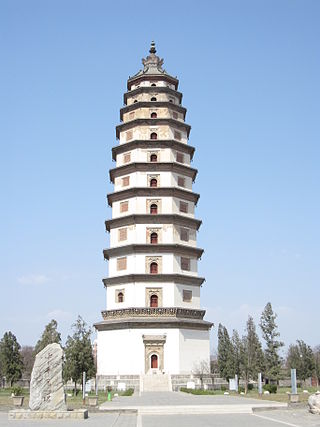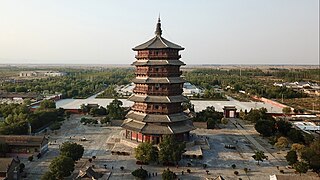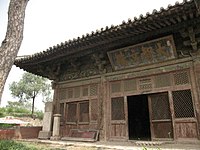
A pagoda is a tiered tower with multiple eaves common to Thailand, Cambodia, Nepal, China, Japan, Korea, Myanmar, Vietnam, and other parts of Asia. Most pagodas were built to have a religious function, most often Buddhist, but sometimes Taoist, and were often located in or near viharas. The pagoda traces its origins to the stupa, while its design was developed in ancient India. Chinese pagodas are a traditional part of Chinese architecture. In addition to religious use, since ancient times Chinese pagodas have been praised for the spectacular views they offer, and many classical poems attest to the joy of scaling pagodas.

Chinese architecture is the embodiment of an architectural style that has developed over millennia in China and has influenced architecture throughout East Asia. Since its emergence during the early ancient era, the structural principles of its architecture have remained largely unchanged. The main changes involved diverse decorative details. Starting with the Tang dynasty, Chinese architecture has had a major influence on the architectural styles of neighbouring East Asian countries such as Japan, Korea, Vietnam, and Mongolia in addition to minor influences on the architecture of Southeast and South Asia including the countries of Malaysia, Singapore, Indonesia, Sri Lanka, Thailand, Laos, Cambodia, and the Philippines.

The caisson, also referred to as a caisson ceiling, or spider web ceiling, in Chinese architecture is an architectural feature typically found in the ceiling of temples and palaces, usually at the centre and directly above the main throne, seat, or religious figure. The caisson is generally a sunken panel set into the ceiling. It is often layered and richly decorated. Common shapes include squares, octagons, hexagons, circles, and a combination of these.

The architecture of the Song dynasty (960–1279) was noted for its towering Buddhist pagodas, enormous stone and wooden bridges, lavish tombs, and extravagant palaces. Although literary works on architecture existed beforehand, architectural writing blossomed during the Song dynasty, maturing into a more professional form that described dimensions and working materials in a concise, organized manner. In addition to the examples still standing, depictions in Song artwork, architectural drawings, and illustrations in published books all aid modern historians in understanding the architecture of the period.

The Liaodi Pagoda of Kaiyuan Monastery, Dingzhou, Hebei Province, China is the tallest existing pre-modern Chinese pagoda and tallest brick pagoda in the world, built in the 11th century during the Song dynasty (960–1279). The pagoda stands at a height of 84 meters (276 ft), resting on a large platform with an octagonal base. Upon completion in 1055, the Liaodi Pagoda surpassed the height of China's previously tallest pagoda still standing, the central pagoda of the Three Pagodas, which stands at 69.13 m (230 ft). The tallest pagoda in pre-modern Chinese history was a 100-meter (330 ft)-tall wooden pagoda tower in Chang'an built in 611 by Emperor Yang of Sui, yet this structure no longer stands. It is considered one of the Four Treasures of Hebei.

The Sakyamuni Pagoda of Fogong Temple of Ying County, Shanxi province, China, is a wooden Chinese pagoda. It is also known as the Wooden Pagoda of Ying County. It was constructed in 1056, during the second year of the Khitan-led Liao dynasty and was renovated and expended in 1195 during the sixth year of the Jin Dynasty. The pagoda was built by Emperor Daozong of Liao (Hongji) at the site of his grandmother's family home. The pagoda, which has survived several large earthquakes throughout the centuries, reached a level of such fame within China that it was given the generic nickname of the "Muta".

The Qian Mausoleum is a Tang dynasty (618–907) tomb site located in Qian County, Shaanxi province, China, and is 85 km (53 mi) northwest from Xi'an. Built in 684, the tombs of the mausoleum complex house the remains of various members of the House of Li, the imperial family of the Tang dynasty. This includes Emperor Gaozong, as well as his wife, Wu Zetian, who assumed the Tang throne and became China's only reigning female emperor from 690 to 705. The mausoleum is renowned for its many Tang dynasty stone statues located above ground and the mural paintings adorning the subterranean walls of the tombs. Besides the main tumulus mound and underground tomb of Emperor Gaozong and Wu Zetian, there are 17 smaller attendant tombs, or peizang mu. Presently, only five of these attendant tombs have been excavated by archaeologists, three belonging to members of the imperial family, one to a chancellor, and the other to a general of the left guard. The Shaanxi Administration of Cultural Heritage declared in 2012 that no further excavations would take place for at least 50 years.

Foguang Temple is a Buddhist temple located five kilometres from Doucun, Wutai County, Shanxi Province of China. The major hall of the temple is the Great East Hall, built in 857 AD, during the Tang dynasty (618–907). According to architectural records, it is the third earliest preserved timber structure in China. It was rediscovered by the 20th-century architectural historian Liang Sicheng (1901–1972) in 1937, while an older hall at Nanchan Temple was discovered by the same team a year later. The temple also contains another significant hall dating from 1137 called the Manjusri Hall. In addition, the second oldest existing pagoda in China, dating from the 6th century, is located in the temple grounds. Today the temple is part of a UNESCO World Heritage site and is undergoing restoration.

Nanchan Temple is a Buddhist temple located near the town of Doucun on Mount Wutai, Shanxi, China. Nanchan Temple was built in 782 during China's Tang dynasty, and its Great Buddha Hall is currently China's oldest preserved timber building extant, as wooden buildings are often prone to fire and various destruction. Not only is Nanchan Temple an important architectural site, but it also contains an original set of artistically important Tang sculptures dating from the period of its construction. Seventeen sculptures share the hall's interior space with a small stone pagoda.

The Dule Temple is a Buddhist temple located in Jizhou District of suburban Tianjin, China. The temple is of historical as well as architectural significance. Its oldest surviving buildings are two timber-frame structures, the front gate and the central hall (pavilion) that houses a colossal clay statue of the Eleven-Headed manifestation of the Bodhisattva Guanyin (Avalokiteśvara). Both structures date back to the Liao dynasty and are among the oldest surviving wooden buildings in China.

Beiyue Temple is a Taoist temple located in Quyang, Hebei Province, China. The temple was used to make sacrifices to Mount Heng by the emperors of the Song dynasty while the mountain was occupied by the Liao dynasty. The Dening Hall of the temple is the largest, earliest and one of the most important extant wooden buildings built in the Yuan dynasty. The temple also contains three gates, an octagonal pavilion and many ancient stelae.

Shanhua Temple is a Buddhist temple located in Datong, Shanxi Province, China. The temple was first founded during the early 8th century of the Tang dynasty, but its earliest surviving building dates from the 11th century. The temple was heavily repaired over the years, and today three original halls and two recently rebuilt pavilions survive. The largest, and earliest hall, dating from the 11th-century Liao dynasty, is the Mahavira Hall and is one of the largest of its kind in China. Also historically significant are the Main Gate and Sansheng Hall, both dating from 12th century during the Jin dynasty.

Zhenguo Temple is a Buddhist temple located 10 km from Pingyao in the village of Hadongcun, in Shanxi Province, China. The temple's oldest hall, the Wanfo Hall, was built in 963 during the Northern Han dynasty, and is notable for featuring very large brackets that hold up the roof and flying eaves. The sculptures inside the hall are among the only examples of 10th century Buddhist sculpture in China.

The Five Dragons Temple is a Taoist temple in Ruicheng, Shanxi Province, China. It is also known as King Guangren's Temple (广仁王庙).

Kaishan Temple is a Buddhist temple located in Xincheng village near Gaobeidian, Hebei Province, China. The temple was first founded in the Tang dynasty, and grew large and important in the subsequent centuries until declining in recent centuries. In the 20th century, the main hall of the temple, dating from 1033 during the Liao dynasty, was used as both a school and as a granary. In 2002, the hall underwent a restoration that was completed in 2007.

Fengguo Temple is a Buddhist temple located in Yixian, Liaoning Province, China. The temple was first founded in 1020 during the Liao dynasty (916–1125), and grew quite large during the subsequent centuries. Today, only two halls, two gates, and a decorative arch survive. The most important surviving building is the Mahavira Hall, a very large hall that dates from 1020. The hall is notable for containing seven large Buddha sculptures, and other smaller sculptures, all dating from the Liao Dynasty. It has had several names over the centuries, including the "Xianxi Temple", "Seven Buddhas Temple" and "Dafengguo Temple".

Phoenix Mosque is a mosque in Hangzhou, Zhejiang, China. It is known for being one of the four great mosques of China. It is also one of the earliest mosque built in China. The origin of this mosque dates back to the Tang or Song dynasty.

The Luohou Temple is a Buddhist temple located in Taihuai Town of Wutai County, Xinzhou, Shanxi, China.
The Eight Great Architectures of the Liao Dynasty are a collection of eight Buddhist structures constructed during the Liao Dynasty in China and have been conserved to this day. Buddhism during the Liao Dynasty was influenced by the Tang Dynasty, as Buddhist relics were relocated to the Hebei vassal state for safekeeping following Emperor Wuzong of Tang's suppression of Buddhism. This relocation facilitated the growth of Buddhism in the Khitan ethnic settlements. While many buildings from the Liao Dynasty were destroyed in conflicts, a select few Buddhist structures have been preserved, with the "Eight Great Architectures of the Liao Dynasty" serving as notable examples. Despite their initial construction during the Liao Dynasty, these buildings have undergone various degrees of restoration or reconstruction in subsequent eras. They are all designated as the most significant immovable cultural relics in China and are classified as major cultural heritage sites under national-level protection.



















